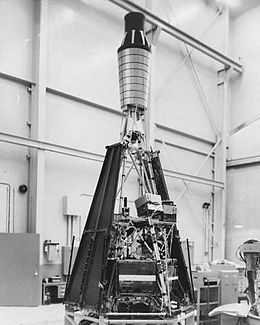Ranger 2
 Ranger 2 | |
| Mission type | Technology |
|---|---|
| Operator | NASA |
| Harvard designation | 1961 Alpha Theta 1 |
| SATCAT № | 206 |
| Mission duration | 2 days |
| Spacecraft properties | |
| Manufacturer | Jet Propulsion Laboratory |
| Launch mass | 304 kilograms (670 lb) |
| Start of mission | |
| Launch date | 18 November 1961, 08:09:00 UTC |
| Rocket | Atlas LV-3 Agena-B |
| Launch site | Cape Canaveral LC-12 |
| End of mission | |
| Decay date | 20 November 1961 |
| Orbital parameters | |
| Reference system | Geocentric |
| Regime |
Low Earth (High Earth planned) |
| Semi-major axis | 6,574.2 kilometres (4,085.0 mi) |
| Perigee | 150 kilometres (93 mi) |
| Apogee | 242 kilometres (150 mi) |
| Inclination | 33.3 degrees |
| Period | ~89 minutes |
| Instruments | |
|
Lyman-Alpha Telescope Magnetometer | |
Ranger 2 was a flight test of the Ranger spacecraft system of the NASA Ranger program designed for future lunar and interplanetary missions. Ranger 2 was designed to test various systems for future exploration and to conduct scientific observations of cosmic rays, magnetic fields, radiation, dust particles, and a possible hydrogen gas "tail" trailing the Earth.[1]
Spacecraft design
Ranger 2 was of the Ranger Block 1 design and was almost identical to Ranger 1. The spacecraft consisted of a hexagonal base 1.5 m across upon which was mounted a cone-shaped 4 m high tower of aluminum struts and braces. Two solar panel wings measuring 5.2 m from tip to tip extended from the base. A high-gain directional dish antenna was attached to the bottom of the base. Spacecraft experiments and other equipment were mounted on the base and tower. Instruments aboard the spacecraft included a Lyman-alpha telescope, a rubidium-vapor magnetometer, electrostatic analyzers, medium-energy-range particle detectors, two triple coincidence telescopes, a cosmic-ray integrating ionization chamber, cosmic dust detectors, and scintillation counters.[1]
The communications system included the high gain antenna and an omni-directional medium gain antenna and two transmitters at approximately 960 MHz, one with 0.25 W power output and the other with 3 W power output. Power was to be furnished by 8680 solar cells on the two panels, a 53.5 kg silver-zinc battery, and smaller batteries on some of the experiments. Attitude control was provided by a solid state timing controller, Sun and Earth sensors, gyroscopes, and pitch and roll jets. The temperature was controlled passively by gold plating, white paint, and polished aluminum surfaces.[1]
Mission
The spacecraft was launched into a low Earth parking orbit, but an inoperative roll gyro prevented Agena restart. The spacecraft could not be put into its planned deep space trajectory, resulting in Ranger 2 being stranded in low Earth orbit upon separation from the Agena stage. The orbit decayed, and the spacecraft reentered Earth's atmosphere on 20 November 1961.[1]
See also
Footnotes
References
- "National Space Science Data Center - Ranger 2". National Air and Space Administration. Retrieved 19 June 2012.
External links
- Space Flight Operations Memorandum - Ranger 2 (Post-flight Mission Analysis)
- Lunar impact: A history of Project Ranger (PDF) 1977
| ||||||||||